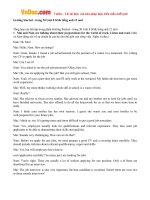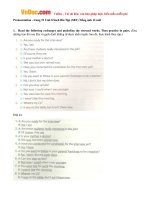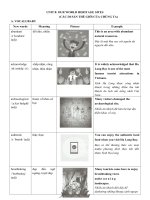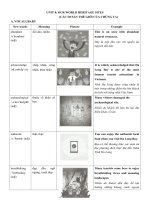Unit 8 our world heritage sites
Bạn đang xem bản rút gọn của tài liệu. Xem và tải ngay bản đầy đủ của tài liệu tại đây (367.8 KB, 11 trang )
UNIT 8: OUR WORLD HERITAGE SITES
(CÁC DI SẢN THẾ GIỚI CỦA CHÚNG TA)
A. VOCALUBARY
New words
abundant
Meaning
dồi dào, nhiều
/əˈbʌndənt/
(adj)
Picture
Example
This is an area with abundant
natural resources.
Đây là một khu vực với nguồn tài
nguyên dồi dào.
acknowledge
chấp nhận, công
It is widely acknowledged that Ha
/əkˈnɒlɪdʒ/ (v)
nhận, thừa nhận
Long Bay is one of the most
famous
tourist
attractions
in
Vietnam.
Vịnh Hạ Long được công nhận là
một trong những điểm thu hút khách
du lịch nổi tiếng nhất Việt Nam.
archaeological
/ˌɑːkiəˈlɒdʒɪkl/
(adj)
authentic
thuộc về khảo cổ
học
Many visitors damaged the
archaeological site.
Nhiều du khách đã làm hư hại địa
điểm khảo cổ này.
thật, thực
/ɔːˈθentɪk/ (adj)
You can enjoy the authentic local
food when you visit Ha Long Bay.
Bạn có thể thưởng thức các món ăn
địa phương đích thực khi đến thăm
Vịnh Hạ Long.
breathtaking
/ˈbreθteɪkɪŋ/
(adj)
đẹp
đến
ngỡ
ngàng, tuyệt đẹp
Many tourists come here to enjoy
breathtaking views and stunning
landscapes.
Nhiều du khách đến đây để tận
hưởng những khung cảnh ngoạn
mục và cảnh quan tuyệt đẹp.
bury
/ˈberi/ (v)
chôn vùi, giấu
trong lòng đất
Many
important
things
were
buried in the area.
Nhiều đồ vật quan trọng đã bị chôn
vùi tại khu vực này.
complex
quẩn thể, tổ hợp
/ˈkɒmpleks/ (n)
The Complex of Hue Monuments
was recognized as World Cultural
Heritage Site
Quần thể Di tích Cố đô Huế được
công nhận là Di sản văn hóa thế
giới.
craftsman
thợ thủ công
/ˈkrɑːftsmən/
(n)
They like buying clothes and other
handicrafts
made
by
local
craftsmen here.
Họ thích mua quần áo và các đổ thủ
công khác được làm bởi những thợ
thủ công địa phương nơi đây.
cruise
/kruːz/ (n)
chuyến du ngoạn
trên biển
Cruise tours are very popular in
this place.
Các chuyến du lịch trên biển rất phổ
biến ở nơi này.
cuisine
/kwɪˈziːn/ (n)
cách thức chế biến
thức
ăn,
nấu
nướng
Vietnamese
cuisine
is
an
attraction for foreign tourists.
Ẩm thực Việt Nam là một điểm thu
hút du khách nước ngoài.
demolish
/dɪˈmɒlɪʃ/ (v)
đổ sập, đánh sập
The old building was demolished
last year.
Tòa nhà cũ này đã bị đánh sập năm
ngoái.
distinctive
/dɪˈstɪŋktɪv/
(adj)
dome
/dəʊm/ (n)
nổi bật, rõ rệt, đặc
trưng
mái vòm
I like this kind of food because it
has a distinctive taste.
Tôi thích món ăn này vì nó có mùi vị
đặc trưng.
The dome of the building has a
very special structure.
Mái vòm của tòa nhà này có một
cấu trúc rất đặc biệt.
dynasty
triều đại
/ˈdɪnəsti/ (n)
This dynasty ruled my country for
hundreds of years.
Triều đại này đã cai trị đất nước tôi
trong hàng trăm năm.
emperor
hoàng đế,
/ˈempərə(r)/ (n) nhà vua
He was the first emperor in the
history of the empire.
Ông ấy là vị hoàng đế đầu tiên trong
lịch sử của đế chế này.
endow
/ɪnˈdaʊ/ (v)
ban tặng
He was endowed with intelligence.
Anh ấy được trời phú cho trí thông
minh.
excavation
/ˌekskəˈveɪʃn/
(n)
việc khai quật
Many relics were found during
archaeological excavations.
Nhiều di tích đã được tìm thấy
trong các cuộc khai quật khảo cổ.
fauna
/ˈfɔːnə/ (n)
hệ động vật
When you come here, you can
explore the cave sand grottos, and
see the local flora and fauna.
Khi đến đây, bạn có thể khám phá
flora
/ˈflɔːrə/ (n)
hệ thực vật
geological
thuộc về địa chất
các hang động lớn nhỏ và ngắm
nhìn hệ động, thực vật địa phương.
/ˌdʒiːəˈlɒdʒɪkl/
(adj)
Some valuable information about
the
Earth's
geological
development can be found in this
place.
Một vài thông tin giá trị về sự phát
triển địa chất của Trái Đất có thể
được tìm thấy tại nơi đây.
hang
grotto
/ˈɡrɒtəʊ/ (n)
The tour of cave and grotto
system is the main attraction for
tourists in Phong Nha cave.
Chuyến tham quan vòng quanh hệ
thống hang động là điểm thu hút
chính đối với du khách tới thăm
động Phong Nha.
harmonious
/hɑːˈməʊniəs/
(adj)
hài hòa
The harmonious blend of colors
makes a contribution to
the
beauty of the building.
Sự pha trộn màu sắc hài hòa đã góp
phần vào vẻ đẹp của tòa nhà này.
in
(idiom)
/ˈruːɪn/
ruins bị phá hủy, đổ
nát
The monument is in ruins.
Tượng đài này đang bị hủy hoại.
intact
/ɪnˈtækt/ (adj)
nguyên vẹn,
không bị hư tổn
The Flag Tower of Hanoi is the only
structure that is still intact.
Cột cờ Hà Nội là công trình còn
nguyên vẹn duy nhất.
islet
/ˈaɪlət/ (n)
hòn đảo nhỏ
They live on the islet.
Họ sống trên hòn đảo nhỏ.
itinerary
lịch trình cho
/aɪˈtɪnərəri/ (n)
chuyến đi, lộ trình
There are different itineraries so
you can experience many things.
Có các lộ trình khác nhau để bạn
trải nghiệm được nhiều thứ.
magnificent
tuyệt đẹp, lộng
/mæɡˈnɪfɪsnt/
(adj)
lẫy
The
building
is
absolutely
magnificent.
Tòa nhà này vô cùng lộng lẫy.
mosque
/mɒsk/ (n)
nhà thờ hồi giáo
The mosque was built here in the
seventeenth century.
Nhà thờ Hồi giáo này được xây
dựng tại đây vào thế kỷ thứ 17
relic
/ˈrelɪk/ (n)
cổ vật
Some relics from ancient times
are on display at the national
museum.
Một số cổ vật từ thời cổ đại đang
được trưng bày tại bảo tàng quốc
gia.
respectively
theo thứ tự lần
lượt
My two daughters are 3 and 5
/rɪˈspektɪvli/
(adv)
royal
/ˈrɔɪəl/ (adj)
respectively.
Hai đứa con gái của tôi lần lượt là 3
tuổi và 5 tuổi.
thuộc về nhà vua,
hoàng gia
You can visit the royal tombs to
find out about the lives of the
royal families.
Bạn có thể ghé thăm các ngôi mộ
hoàng gia để tìm hiểu về các gia
đình hoàng tộc.
sanctuary
/ˈsæŋktʃuəri/
(n)
thánh địa, địa
điểm thần thánh
My Son Sanctuary is one of the
five World Heritage Sites in
Vietnam.
Thánh địa Mỹ Sơn là một trong năm
Di sản thế giới tại Việt Nam
subsequent
/ˈsʌbsɪkwənt/
(adj)
tiếp theo, kế tiếp
Most of the citadel expanded by
subsequent
dynasties
was
demolished
Hầu hết các tòa thành được mở
rộng bởi các triều đại sau đã bị phá
hủy.
B. GRAMMAR
Participle and to - infìnitive clauses (Mệnh đề bắt đầu bằng một ngữ phân từ và động từ nguyên
mẫu có TO)
Mệnh đề quan hệ có dạng: who/ which / that + V có thể được rút gọn bằng những cách sau:
1. Dùng hiện tại phân từ V-ing (present participle)
Dùng V-ing khi mệnh đề quan hệ ở chủ động: who / which / that + V (active) →V-ing
E.g: The girl who is talking to Mr. Huy is my younger sister→The girl talking to Mr. Huy is my
younger sister. (Cô gái đang nói chuyện với Thầy Huy là em gái tôi.)
2. Dùng quá khứ phân từ V-ed/V3 (past participle)
Dùng V-PP khi mệnh đề quan hệ ở bị động: who / which / that + V (passive) →V-PP
E.g: The lamp which was made in China is five dollars. =The lamp made in China is five dollars. (Chiếc
đèn được sản xuất ở Trung Quốc có giá 5 đô la)
3. Dùng động từ nguyên mẫu có TO (to -infinitive)
Dùng to V khi:
- Danh từ phía trước đại từ quan hệ đứng trước một số từ như: the first, the second, etc., the next, the
last, the only; và đôi khi trước hình thức so sánh bậc nhất như the oldest, the most beautiful........(the
only, the first...) + N + relative pronouns (who/ which/ that) + V → to V (chủ động); to be PP (bị
động)
E.g: He was the first person who came here yesterday. → He was the first person to come here yesterday
(Anh ấy là người đầu tiên đến đây vào hôm qua.)
She is the only person who is called for the interview. → She is the only person to be called for the
interview.
- Động từ phía trước là HAVE/HAS để diễn tả mục đích,
E.g: He had something that he had to do. → He had something to do. (Anh ấy có một số việc phải
làm.) I have a lot of homework which I have to do now. → I have a lot of homework to do now.
+ Đầu câu có HERE (BE), THERE (BE)
E.g: There are ten messages which are sent today. → There are ten messages to be sent today.
4. Dùng cụm danh từ/ giới từ
Dùng cụm danh từ/ giới từ khi mệnh đề quan hệ có dạng:
S + BE + Noun/ Noun phrases /Prepositional phrases
Cách làm: ta bỏ who, which và be
E.g: Football, which is a popular sport, is very good for our health.
Football, a popular sport, is very good for our health.
■ BÀI TẬP VẬN DỤNG CƠ BẢN
Bài 1: Choose the best answer.
1. The students
for the bus are good ones.
A. waited
B. waiting
2. This is the last person
A. coming
3. The woman
C. which is waiting
D. to wait
C. come
D. all are correct
late.
B. to come
next door is a famous actress.
A. lives
4. The house
B. who live
B. destroying
B. stands
6. Tom was the last student
A. to leave
A. was designed
9. The ring
A. she is wearing it
C. standing
B. leaving
C. left
D. to stand
D. leaves
in the final exam.
B. asking
C. asks
D. to ask
by French architects is very nice.
B. designing
C. to design
D. designed
is made of gold and diamond.
B. he gave it to her
10. 1 have a message for people
A. to delay
D. that is destroyed
the classroom yesterday.
7. Sally was the last student
8. The bridge
C. which destroyed
in front of the blackboard is our teacher.
A. stood
A. to be asked
D. that living
in the storm has now been rebuilt.
A. destroyed
5. The man
C. living
C. she like
D. she is wearing
by the traffic chaos.
B. who delay
C. delayed
D. who delaying
Bài 2: Use a participle clause to reduce relative clauses.
1. They called a lawyer who lived nearby.
.
2. We broke the computer that belongs to my father.
.
3. The man who is wearing a blue jumper is in the garden.
.
4. We found a doctor who works at a hospital in Hanoi City.
.
5. People who have arrived late will not be allowed to enter.
.
6. Don't wake the baby who is sleeping in the next room.
.
7. Who is that boy who is walking in the forest?
.
8. The man who wants coffee is over there.
.
9. The television which was bought 20 years ago was stolen.
.
10. I often buy cheese which is imported from Paris.
.
Bài 3: Replace the Relative Clause by a Participle Construction while keeping the rest of the sentence
unchanged.
1. The boy who was waiting in the hall expected a phone call.
.
2. Passengers who wanted to go to Liverpool had to change in Manchester.
.
3. The girl who was picked up by her brother was very nice.
.
4. The house that stands at the end of the road will soon be sold.
.
5. The conference which was planned by non-governmental organisations was about globalisation.
.
6. Irish people who live in Great Britain have the right to vote in British elections.
.
7. A friend who helps you in need is a good friend indeed.
.
8. A picture that shows the image of a person is a portrait.
.
9. The problems that were discussed will be essential for your exam.
.
10. Animals that eat plants are called herbivores.
.
Bài 4: Rewrite the sentences using reduced relative clauses.
1. The present that was given to me last night must have been very expensive. It certainly is beautiful.
.
2. Claire Baktne, who was born in 1843, was a true representative of the hopes of hundreds of
immigrants.
.
3. Frequently, computers which are considered obsolete at large companies are donated to charity
institutions or community centers in poor neighborhoods.
.
4. The mall which was built in the downtown area of the city has affected traffic considerably.
.
5. The children who were selected for the team will start training in a couple of weeks.
.
6. The new construction company promises to hire all the engineering students who will have graduated
from MIT by the end of next year.
.
7. Alexander G. Bell, who was considered the inventor of the telephone until recently, simply obtained
the patent that belonged to an Italian inventor.
.
8. The stamp which is on that envelope is a rare collector's item.
.
Bài 5: Shorten these sentences without changing the order. Where it's not possible to shorten them,
write "Cannot be shortened".
1. I've just read a book that was called Life without limit.
.
2. Save electricity by reducing the number of computers that are left on overnight.
.
3. Did you watch the film which I recommended to you?
.
4. I met Jeff last week, whom I believe you know from the office.
.
5. I thought the man who was walking down the street was my neighbour.
.
■ BÀI TẬP TỔNG HỢP NÂNG CAO
Bài 6: Choose the underlined part that needs correction in each of the following questions.
1. (A) The waiter (B) whom served us yesterday (C) was polite and (D) friendly.
2. This class (A) is only (B) for people (C) who's first language (D) is not English.
3. This is (A) the boy (B) who sister (C) studied (D) with me at high school.
4. He (A) is moving to Lang Son city, (B) that is (C) in the north-east (D) of Vietnam.
5. The girl (A) whom is standing (B) over there (C) is (D) from Vietnam.
Bài 7: Choose the sentence that best combines each pair of sentences in the following questions.
1. He likes the dress. Linda is wearing it.
A. He likes the dress which Linda is wearing it.
B. He likes the dress Linda is wearing it.
C. He likes the dress who Linda is wearing.
D. He likes the dress Linda is wearing.
2. What was the name of the boy? You met and talked to him this morning.
A. What was the name of the boy who you met and talked to him this morning?
B. What was the name of the boy you met and talked to this morning?
C. What was the name of the boy you met and talked to whom this morning?
D. What was the name of the boy whose you met and talked to this morning?
3. The church is over 200 years old. Our class visited it last summer.
A. The church which our class visited it last summer is over 200 years old.
B. The church that our class visited it last summer is over 200 years old.
C. The church which our class visited last summer is over 200 years old.
D. The church our class visit last summer is over 200 years old.
4. The song says about the love of two young students. She is singing the song.
A. The song which she is singing it says about the love of two young students.
B. The song she is singing says about the love of two young students.
C. The song says about the love of two young students which she is singing.
D. The song says about the love of two young students that she is singing it.
5. The man is my teacher. I am grateful to him.
A. The man whom I grateful to him is my teacher.
B. The man whom I am grateful to is my teacher.
C. The man is my teacher who is grateful.
D. The man to him I am grateful is my teacher.
Bài 8: Rewrite the sentences using reduced relative clauses.
1. Do you know the woman who is coming toward us?
.
2. The students who have been waiting for the bus in the rain are getting wet.
.
3. I come from a city that is located in the southern part of the country.
.
4. They live in a house that was built in the 1990s.
.
5. He was the first man who left the burning building.
.
6. The couple who live in the house next door are both professors.
.
7. The cat which is on the table is mine.
.
8. The students who left school early yesterday have to explain their reason to the teacher.
.
9. Did you get the message which concerned the special meeting?
.
10. Lan is the only person who was given a special gift this morning.
.









